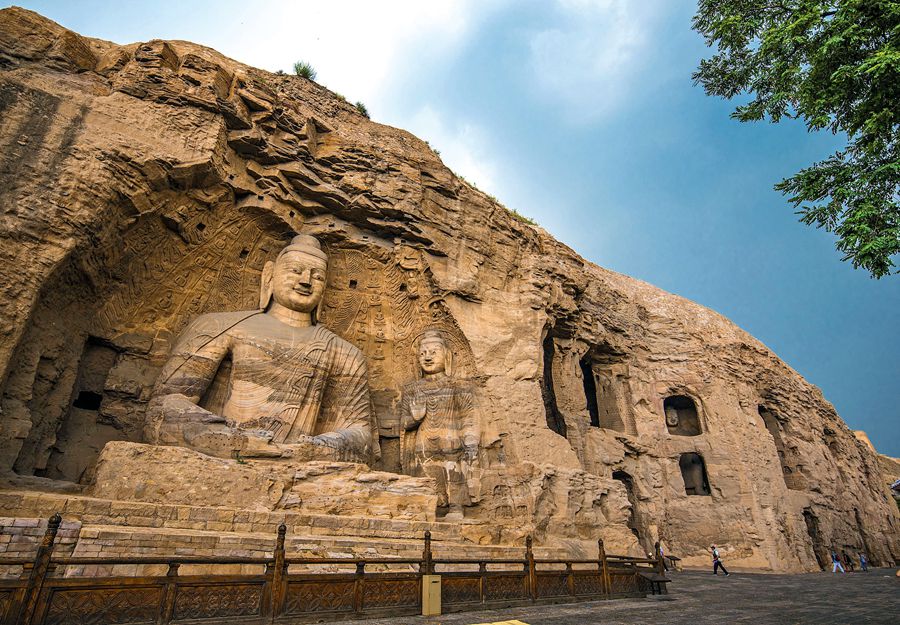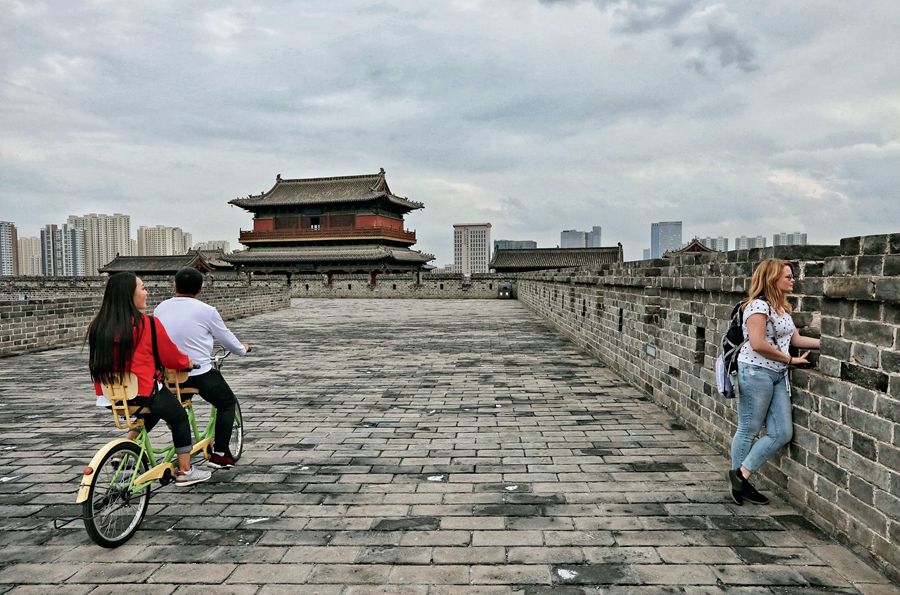DATONG is the second largest city of Shanxi Province. The city meets the Inner Mongolia Autonomous Region and Hebei Province in the north. Its geographical location makes it a place of military importance since ancient times.

The Yungang Grottoes, stretching one kilometer in length, are magnificently carved on large rocks at the foot of a mountain.
Datong boasts a long history and rich touristic resources, which makes it one of the most renowned historic and cultural cities in China. Some say that to study Chinese history, the cultural relics in Shanxi, of which Datong has many, cannot be missed. Historically, Datong was the capital of the Northern Wei Dynasty (368-534) from 398 to 493, the secondary capital of the Liao (916-1125)and Jin (415-1234) dynasties, and a place of strategic importance during the Ming and Qing (1368-1911) dynasties. The Yungang Grottoes in Datong are the biggest surviving ones of their kind discovered in China. The World Cultural Heritage Committee of the UNESCO has inscribed them on the World Cultural Heritage List. One of the five sacred mountains in China, Mount Hengshan houses Xuankong Temple, literally Hanging Temple. Standing high up the steep cliffs, the temple represents a mix of Buddhist, Taoist, and Confucian doctrines. The key Sanggan River runs across the city from west to northeast and adds exquisiteness to the city. The ancient city wall in Datong is well preserved and open to visitors free of charge after its restoration. It is a delight to the eye.
The high-speed rail, expected to be operational next year, will shorten the travel time from Datong to Beijing to less than two hours. Datong is incorporating into coordinated development of the Beijing-Tianjin-Hebei region, and emerges as a fabulous garden in Beijing’s backyard. Famous for its rich coal deposits in the past decades, the city has now come back into the limelight as an ancient city.
A City of Diverse Cultures
According to history books, Datong, then named Pingcheng City, was a frontier city of strategic significance in the third century B.C.
Connecting the Inner Mongolian Plateau on the north and the North China Plain on the east, Datong boasts fertile farmland and grasslands. Throughout history, nomads and farmers fought over it for years. Multiple ethnic groups intermingled and created diverse cultures prospering in harmony.

On September 14, 2018, tourists cycle through the ancient city of Datong, Shanxi Province.
The migrating ethnic groups from the north in the fourth and fifth centuries brought prosperity to Datong. In 396, the Northern Wei Dynasty, founded by the Xianbei nomadic groups, moved the capital to Datong. The city then emerged as the political, economic, and cultural center in north China.
The founding father of the Northern Wei Dynasty is Tuoba Gui. He admired the splendid culture of the Central Plains and encouraged integration with the Han culture. He adopted the Han system of governance and appointed Han officials. The Xianbei people used to live nomadically. After the founding of the Northern Wei Dynasty, they were encouraged to farm on land distributed to them based on the land system of the Han people. Together with other ethnic groups, Xianbei people obtained land and became farmers like the Han people. The nomadic people had no written language. They recorded events by carving on the wood and knotting ropes. To promote education, the emperor built up a national university, and encouraged children of ethnic minority groups to study Han culture. Today, inscribed steles in Datong not only record the history of the Northern Wei Dynasty, but also showcase a new genre of Chinese calligraphic art.
In addition, rulers of the Northern Wei Dynasty also reformed Buddhism by incorporating Taoist and Confucian doctrines and Chinese political beliefs. The Hanging Temple, built at that time, represents the integration of Buddhism, Taoism, and Confucianism.
One thing worth mentioning is that, during this period, the Buddha statues in every temple represented a combination of the Buddha and the emperor, a peculiar phenomenon in Chinese history. The localization of Buddhism is of historic significance. It helped the nomadic people integrate with people of different ethnicities, creating conditions for social stability. Thanks to this foundation, Buddhism prevailed in the Sui and Tang dynasties (618-907).
The Ancient City
Datong was included in the territory of the Ming Empire the year after the Ming Dynasty (1368-1644) united China. As a pivotal city in the frontier, its walls were fortified. Today’s Datong is developed upon this layout. The whole city looks like a chessboard with crisscrossing streets dividing it into four parts, each of which was further divided into four parts till the primary level of residential communities.
City walls built during the Ming Dynasty are magnificent and formed a formidable defense system. The foundation was fortified with stone bars, plates, and pillars. The main body was built with bricks made of lime, clay, and fine sand, with the periphery cladded with grey bricks. The present city walls underwent restoration for eight years since 2009. Now, the walls separate Datong into two different worlds. Outside the walls are towering high-rises and highways comparable to those of any metropolis, whereas inside the walls, the city retains the appeal of ancient times created by scaled houses and stately temples.
The newly-repaired city walls measure 7.24 km in length and 14 meters in height. There are four main gates, and fortifications like drawbridges, watchtowers, and a moat surrounding the ancient city. The four observatory platforms at the four corners of the city are unique in design. They helped guards avoid blind spots in the past.
During the Spring Festival, people flock to the city walls for the annual temple fair. It lasts for 16 days from the first day of the first lunar month. Local people have been maintaining the tradition of mounting the walls for the beautiful ancient cityscape and exhorting the gods to shower them with good fortune at the Huayan Temple and Yuantong Temple. The fair features a variety of performances of traditional and folk arts, as well as handicraft exhibitions. As dusk falls, the ancient city dazzles visitors with luminous streets decorated with colorful traditional lanterns and state-of-the-art lights.
Food in Datong
Shanxi has long enjoyed the reputation of “home to Chinese wheaten food.” Datong food is the representative of delicacies in north Shanxi.
Local specialties include sliced noodles, millet cakes, and naked oat noodles among others. The flavors have been influenced by nomadic people thanks to the city’s unique history.
Dishes made from naked oat flour are popular among local people. They can be steamed, boiled, fried, or served cold with dressings. Rich in calcium, phosphorus, iron, riboflavin, and many other nutrients essential to human body, food made from naked oat is especially suitable for people with diabetes or high blood pressure. As such food is not easily digestible, limited amount of intake is recommended.
Millet cakes are household snacks in Datong. Doughs of millet flour are steamed first. Then, the cooked doughs are kneaded repeatedly while being applied with sesame oil. When they are springy enough, they are cut into small cubes and served with gravy. The dish is chewy, but retains a soft texture.
The most renowned dish in Datong is its sliced noodles. Its fame comes from the unique cooking method. To make authentic sliced noodles, the ingredients of flour and water should be precisely proportioned, and the dough should be fully kneaded. Perfect noodles resemble willow leaves and have a slippery and chewy feel. The cook, like an artist, stages an entertaining performance when slicing the noodles. Holding a tile-shaped knife, he stands in front of a cauldron brimming with boiling water. As he skillfully moves the knife on the dough over the head, a cascade of slices pours into the water. A full bowl of sliced noodles is the most effective cure for homesickness for those who travel afar.

